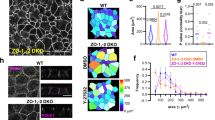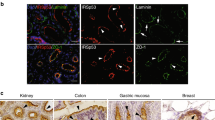Abstract
Apical-domain constriction is important for regulating epithelial morphogenesis. Epithelial cells are connected by apical junctional complexes (AJCs) that are lined with circumferential actomyosin cables. The contractility of these cables is regulated by Rho-associated kinases (ROCKs). Here, we report that Willin (a FERM-domain protein) and Par3 (a polarity-regulating protein) cooperatively regulate ROCK-dependent apical constriction. We found that Willin recruits aPKC and Par6 to the AJCs, independently of Par3. Simultaneous depletion of Willin and Par3 completely removed aPKC and Par6 from the AJCs and induced apical constriction. Induced constriction was through upregulation of the level of AJC-associated ROCKs, which was due to loss of aPKC. Our results indicate that aPKC phosphorylates ROCK and suppresses its junctional localization, thereby allowing cells to retain normally shaped apical domains. Thus, we have uncovered a Willin/Par3–aPKC–ROCK pathway that controls epithelial apical morphology.
This is a preview of subscription content, access via your institution
Access options
Subscribe to this journal
Receive 12 print issues and online access
$209.00 per year
only $17.42 per issue
Buy this article
- Purchase on Springer Link
- Instant access to full article PDF
Prices may be subject to local taxes which are calculated during checkout





Similar content being viewed by others
References
Lecuit, T. & Lenne, P. F. Cell surface mechanics and the control of cell shape, tissue patterns and morphogenesis. Nat. Rev. Mol. Cell Biol. 8, 633–644 (2007).
Blankenship, J. T., Backovic, S. T., Sanny, J. S., Weitz, O. & Zallen, J. A. Multicellular rosette formation links planar cell polarity to tissue morphogenesis. Dev. Cell 11, 459–470 (2006).
Bertet, C., Sulak, L. & Lecuit, T. Myosin-dependent junction remodelling controls planar cell intercalation and axis elongation. Nature 429, 667–671 (2004).
Vicente-Manzanares, M., Ma, X., Adelstein, R. S. & Horwitz, A. R. Non-muscle myosin II takes centre stage in cell adhesion and migration. Nat. Rev. Mol. Cell Biol. 10, 778–790 (2009).
Riento, K. & Ridley, A. J. Rocks: multifunctional kinases in cell behaviour. Nat. Rev. Mol. Cell Biol. 4, 446–456 (2003).
Hildebrand, J. D. Shroom regulates epithelial cell shape via the apical positioning of an actomyosin network. J. Cell Sci. 118, 5191–5203 (2005).
Nishimura, T. & Takeichi, M. Shroom3-mediated recruitment of Rho kinases to the apical cell junctions regulates epithelial and neuroepithelial planar remodeling. Development 135, 1493–1502 (2008).
Nakajima, H. & Tanoue, T. Epithelial cell shape is regulated by Lulu proteins via myosin-II. J. Cell Sci. 123, 555–566 (2010).
Suzuki, A. & Ohno, S. The PAR-aPKC system: lessons in polarity. J. Cell Sci. 119, 979–987 (2006).
Izumi, Y. et al. An atypical PKC directly associates and colocalizes at the epithelial tight junction with ASIP, a mammalian homologue of Caenorhabditis elegans polarity protein PAR-3. J. Cell Biol. 143, 95–106 (1998).
Joberty, G., Petersen, C., Gao, L. & Macara, I. G. The cell-polarity protein Par6links Par3 and atypical protein kinase C to Cdc42. Nat. Cell Biol. 2, 531–539 (2000).
Suzuki, A. et al. Atypical protein kinase C is involved in the evolutionarily conserved par protein complex and plays a critical role in establishing epithelia-specific junctional structures. J. Cell Biol. 152, 1183–1196 (2001).
Kuchinke, U., Grawe, F. & Knust, E. Control of spindle orientation in Drosophilaby the Par-3-related PDZ-domain protein Bazooka. Curr. Biol. 8, 1357–1365 (1998).
Wodarz, A., Ramrath, A., Grimm, A. & Knust, E. Drosophila atypical protein kinase C associates with Bazooka and controls polarity of epithelia and neuroblasts. J. Cell Biol. 150, 1361–1374 (2000).
Petronczki, M. & Knoblich, J. A. DmPAR-6 directs epithelial polarity and asymmetric cell division of neuroblasts in Drosophila . Nat. Cell Biol. 3, 43–49 (2001).
Gunn-Moore, F.J. et al. A novel 4.1 ezrin radixin moesin (FERM)-containing protein, ‘Willin’. FEBS Lett. 579, 5089–5094 (2005).
Pan, D. The Hippo signaling pathway in development and cancer. Dev. Cell 19, 491–505 (2010).
Hamaratoglu, F. et al. The tumour-suppressor genes NF2/Merlin and Expanded act through Hippo signalling to regulate cell proliferation and apoptosis. Nat. Cell Biol. 8, 27–36 (2006).
Chen, X. & Macara, I. G. Par-3 controls tight junction assembly through the Rac exchange factor Tiam1. Nat. Cell Biol. 7, 262–269 (2005).
Liu, Y., Fisher, D. A. & Storm, D. R. Intracellular sorting of neuromodulin (GAP-43) mutants modified in the membrane targeting domain. J. Neurosci. 14, 5807–5817 (1994).
Ebnet, K. et al. The cell polarity protein ASIP/PAR-3 directly associates with junctional adhesion molecule (JAM). EMBO J. 20, 3738–3748 (2001).
Horikoshi, Y. et al. Interaction between PAR-3 and the aPKC-PAR-6 complex is indispensable for apical domain development of epithelial cells. J. Cell Sci. 122, 1595–1606 (2009).
McCaffrey, L. M. & Macara, I. G. The Par3/aPKC interaction is essential for end bud remodeling and progenitor differentiation during mammary gland morphogenesis. Genes Dev. 23, 1450–1460 (2009).
Hao, Y. et al. Par3 controls epithelial spindle orientation by aPKC-mediated phosphorylation of apical pins. Curr. Biol. 20, 1809–1818 (2010).
Warner, S. J. & Longmore, G. D. Cdc42 antagonizes Rho1 activity atadherens junctions to limit epithelial cell apical tension. J. Cell Biol. 187, 119–133 (2009).
Georgiou, M., Marinari, E., Burden, J. & Baum, B. Cdc42, Par6, and aPKC regulate Arp2/3-mediated endocytosis to control local adherens junction stability. Curr. Biol. 18, 1631–1638 (2008).
Leibfried, A., Fricke, R., Morgan, M. J., Bogdan, S. & Bellaiche, Y. Drosophila Cip4 and WASp define a branch of the Cdc42-Par6-aPKC pathway regulating E-cadherin endocytosis. Curr. Biol. 18, 1639–1648 (2008).
Morais-de-Sa, E., Mirouse, V. & St Johnston, D. aPKC phosphorylation of Bazooka defines the apical/lateral border in Drosophila epithelial cells. Cell 141, 509–523 (2010).
Zallen, J. A. & Wieschaus, E. Patterned gene expression directs bipolar planar polarity in Drosophila . Dev. Cell 6, 343–355 (2004).
Simoes Sde, M. et al. Rho-kinase directs Bazooka/Par-3 planar polarity during Drosophila axis elongation. Dev. Cell 19, 377–388 (2010).
Hamaratoglu, F. et al. The Hippo tumor-suppressor pathway regulates apical-domain size in parallel to tissue growth. J. Cell Sci. 122, 2351–2359 (2009).
Genevet, A. et al. The Hippo pathway regulates apical-domain size independently of its growth-control function. J. Cell Sci. 122, 2360–2370 (2009).
Ishiuchi, T., Misaki, K., Yonemura, S., Takeichi, M. & Tanoue, T. Mammalian Fat and Dachsous cadherins regulate apical membrane organization in the embryonic cerebral cortex. J. Cell Biol. 185, 959–967 (2009).
Klockenbusch, C. & Kast, J. Optimization of formaldehyde cross-linking for protein interaction analysis of non-tagged integrin β1. J. Biomed. Biotechnol. 2010, 927585 (2010).
Amano, M., Fukata, Y., Shimokawa, H. & Kaibuchi, K. Purification and in vitro activity of Rho-associated kinase. Methods Enzymol. 325, 149–155 (2000).
Acknowledgements
We are grateful to K. Shinmyozu for LC-MS/MS analysis. We thank S. Ohno and S. Yonemura for reagents; M. Nomura, H. Saitou and Y. Inoue for technical support; and T. Otani for comments on the research. This work was supported by the programme Grants-in-Aid for Specially Promoted Research of the Ministry of Education, Science, Sports, and Culture of Japan to M.T. T.I. is a recipient of the RIKEN Junior Research Associate fellowship.
Author information
Authors and Affiliations
Contributions
T.I. designed and conducted experiments. T.I. and M.T. wrote the paper.
Corresponding author
Ethics declarations
Competing interests
The authors declare no competing financial interests.
Supplementary information
Supplementary Information
Supplementary Information (PDF 3137 kb)
Rights and permissions
About this article
Cite this article
Ishiuchi, T., Takeichi, M. Willin and Par3 cooperatively regulate epithelial apical constriction through aPKC-mediated ROCK phosphorylation. Nat Cell Biol 13, 860–866 (2011). https://doi.org/10.1038/ncb2274
Received:
Accepted:
Published:
Issue Date:
DOI: https://doi.org/10.1038/ncb2274
This article is cited by
-
An entosis-like process induces mitotic disruption in Pals1 microcephaly pathogenesis
Nature Communications (2023)
-
ASPP2 maintains the integrity of mechanically stressed pseudostratified epithelia during morphogenesis
Nature Communications (2022)
-
MAGIs regulate aPKC to enable balanced distribution of intercellular tension for epithelial sheet homeostasis
Communications Biology (2021)
-
FRMD6 has tumor suppressor functions in prostate cancer
Oncogene (2021)
-
Expression and regulation of FRMD6 in mouse DRG neurons and spinal cord after nerve injury
Scientific Reports (2020)



